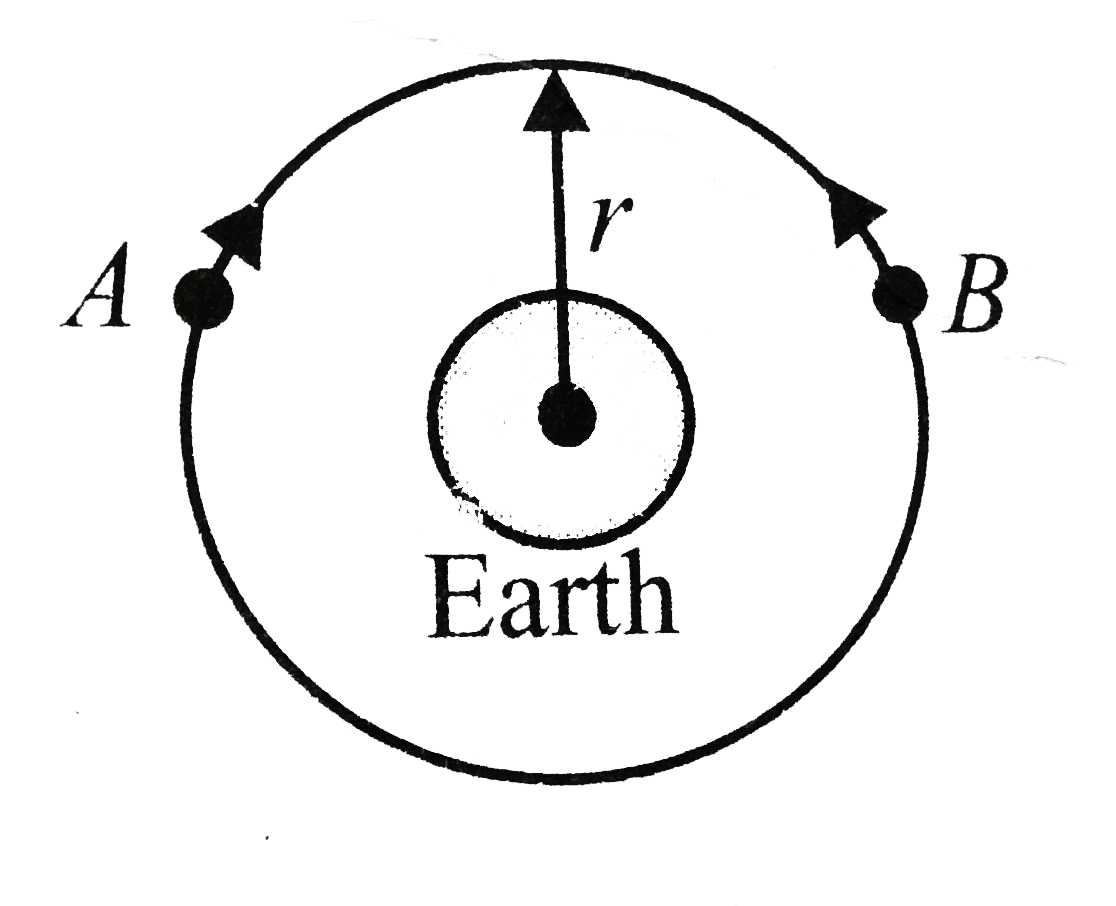Consider two satellites A and B of equal mass m, moving in the same circular orbit of radius r around the earth E but in opposite sense of rotation and therefore on a collision course (see figure).
If the collision is completely inelastic so that wreckage remains as one piece of tangle d material (mass = 2m), find the total mechanical energy immediately after collision.

Topper's Solved these Questions
- GRAVITATIONBook:MOTIONChapter:GRAVITATIONExercise:Exercise - 3 | Level - II (Subjective | JEE Advanced)
Explore 10 Videos
- GRAVITATIONBook:MOTIONChapter:GRAVITATIONExercise:Exercise - 4 | Level - I (Previous year | JEE Main)
Explore 16 Videos
- GRAVITATIONBook:MOTIONChapter:GRAVITATIONExercise:Exercise - 2 (Level - II) Multiple choice | JEE Advanced
Explore 12 Videos
- GEOMETRICAL OPTICSBook:MOTIONChapter:GEOMETRICAL OPTICSExercise:Exercise - 4 | Level-II
Explore 55 Videos
- HEAT - 1Book:MOTIONChapter:HEAT - 1Exercise:EXERCISE -4 (Level - II) Previous Year | JEE Advanced
Explore 22 Videos
Similar Questions
Consider two satellites A and B of equal mass m, moving in the same circular orbit of radius r around the earth E but in opposite sense of rotation and therefore on a collision course (see figure).
In terms of G, Me, m and r find the total mechanical energy EA + EB of the two satellite plus earth system before collision.

View Solution_E01_109_Q01.png)
Consider two satellites A and B of equal mass m, moving in the same circular orbit of radius r around the earth E but in opposite sense of rotation and therefore on a collision course (see figure)
(i). In terms of G,Me m and r find the total mechanical energy EA+EB of the two satellite plus earth system before collision
(ii). If the collision is completely inelastic so that wreckage remains as one piece of tangled material (mass=2m) find the total mechanical energy immediately after collision.
(iii). Describe the subsequent motion of the wreckage.
View Solution
Knowledge Check
Consider two satellites A and B of equal mass m, moving in the same circular orbit about the earth, but in opposite sense as shown in figure. The orbital radius is R. The satellite undergo a collision which is perfectly inelastic. For this situation, mark out the correct statements. [Take mass of earth as M]
 AThe total energy of the satellite plus earth's system before collision is −(GMm)/r.BThe total energy of the two satellites plus earth system just after collision is −(2GMm)/r.CThe total energy of the two satellites plus earth system just after collision −(GMm)/2r.DThe combined mass (two satellites) will fall towards the earth just after collision.
AThe total energy of the satellite plus earth's system before collision is −(GMm)/r.BThe total energy of the two satellites plus earth system just after collision is −(2GMm)/r.CThe total energy of the two satellites plus earth system just after collision −(GMm)/2r.DThe combined mass (two satellites) will fall towards the earth just after collision.Consider two satellites A and B of equal mass m, moving in the same circular orbit about the earth, but in the opposite sense as shown in Fig. The orbital radius is r. The satellites undergo a collision which is perfectly inelastic. For this situation, mark out the correct statement(s). [Take mass of earth as M]
 AThe total energy of the two satellites plus earth system just before collision is −(GMm)/rBThe total energy of the two satellites plus earth system just after collision is −(2GMm)/rCThe total energy of two satellites plus. earth system just after collision is −(GMm)/2r)DThe combined mass (two satellites) will fall towards the earth just after collision.
AThe total energy of the two satellites plus earth system just before collision is −(GMm)/rBThe total energy of the two satellites plus earth system just after collision is −(2GMm)/rCThe total energy of two satellites plus. earth system just after collision is −(GMm)/2r)DThe combined mass (two satellites) will fall towards the earth just after collision.The satellite of mass m revolving in a circular orbit of radius r around the earth has kinetic energy E. then, its angular momentum will be
A√Emr2BE2mr2Csqt(2Emr2)D√2Emr
Consider two satellites A and B of equal mass, moving in the same circular orbit of radius r around the earth but in the opposite sense and therefore a collision occurs.
(a) Find the total mechanical energy EA+EB of the two satellite-plus-earth system before collision.
(b) If the collision is completely inelastic, find the total mechanical energy immediately after collision. Describe the subsequent motion of the combined satellite.
View SolutionTwo indentical geostationary satellite each of mass m are moving with equal speed υ in the same orbit but their sense of rotation brings them on a collision course. What will happen to the debris?
View SolutionA satellite of mass M revolving in a circular orbit of radius rs around the earth of mass M has a total energy E. then, its angular momentum will be
View SolutionTwo satellite of same mass are launched in the same orbit of radius r around the earth so as to rotate opposite to each other. If they collide inelastically and stick together as wreckage, the total energy of the system just after collision is
View SolutionTwo satellites , A and B , have masses m and 2m respectively . A is in a circular orbit of radius R , and B is in a circular orbit of radius 2R around the earth . The ratio of their energies , KAKB is :
View Solution